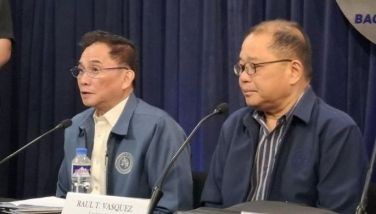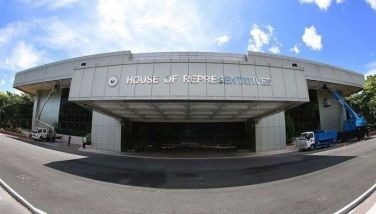Suspension of Solar I captain recommended
September 2, 2006 | 12:00am
The Special Board of Marine Inquiry (SBMI) has recommended the preventive suspension of the captain of MT Solar I that sank off Guimaras island and caused the country’s worst oil spill.
Coast Guard Rear Admiral Danilo Abinoja, head of the 11-man SBMI created to determine who should be liable for the catastrophe, said they have found basis to suspend Solar I Capt. Norberto Aguro.
Aside from suspension, Abinoja said the owner of the fuel tanker, Sunshine Maritime Development Corp. (SMDC), will be fined P35,000 for violating the limit of the number of crew allowed aboard the tanker. The vessel had 18 crewmembers when it can accommodate only 16.
SMDC will also most likely be fined for allowing a shipmaster and some crew to operate the fuel tanker with expired certificates.
The panel found out that Aguro’s certificate on Advanced Training on Chemical Operations had expired in March 2002.
Abinoja said they are looking at three possible factors that led to the sinking of the tanker that carried two million liters of bunker fuel — lack of competency of the captain and the crew, instability of the vessel and external factors.
Aguro, however, had insisted that he could not be held liable as strong waves, not human error or wrong decision, caused the sinking of the oil tanker.
But the owner of SMDC conceded during the hearing that Aguro made a "wrong decision" when he allowed Solar I to sail despite the bad weather and the damage incurred by the vessel when it was hit by huge waves in Guimaras Strait.
Meanwhile, the Philippine Coast Guard (PCG) said yesterday that the leak from the sunken tanker MT Solar I off Guimaras island has slowed down to a trickle.
"Oil is still leaking from the tanker, but the rate has slowed down. We estimate that less than 20 liters of oil are seeping into the sea every hour," PCG on-scene commander Harold Jarder told reporters at a press briefing organized by the Regional Disaster Coordinating Council (RDCC).
The PCG earlier estimated that around 100 to 200 liters of oil was leaking from the ship’s air vent.
PCG vessels, however, remain in the area spraying oil dispersants. There are now seven vessels, nine tugboats and three aircraft involved in operations to contain the oil spill, which has already affected 30,531 individuals according to the RDCC.
Harder also showed the footage of the sunken tanker taken Thursday morning by Hayuko 2000.
Petron Corp. has contracted Fukuda Marine and Salvage Works Co. Ltd., which owns Shinsei Maru and the Hakuyo 2000 to find the exact location of the tanker.
Solar I is in an upright position, with its anchor at portside still up. Jarder said the ship appears to be in good condition, and did not break up when it hit the sandy sea floor.
"We’re happy to note that the rate of the oil spill is weakening," Jarder said. "It is only when the ship is rocked by the current that bunker oil leaks out."
Rolando Salonga, distribution manager of Petron Corp., told the SBMI yesterday that Solar I was in good condition when it started its voyage from Limay, Bataan to Zamboanga City last Aug. 9, carrying two million liters of bunker fuel.
"We always conduct a technical evaluation of all the vessels we charter. It is standard operating procedure before we accredit a tanker operator," Salonga said.
Jarder dismissed speculations that the oil slick has reached Jordan town in Guimaras and Oton town and Iloilo City based on sightings of oil-coated debris.
"These are just rubbish in the sea that were hit by the oil slick," Jarder explained, stressing that there are no new areas affected by the disaster. Those seen in the coasts of Oton were but remnants of oil slick sprayed with chemical dispersants.
The Department of Science and Technology (DOST), which heads Task Force Guimaras, said yesterday that it is expecting to see a marked improvement of the Guimaras coastlines damaged by the oil spill.
DOST Undersecretary Graciano Yumul Jr. made the assessment during his visit in Zamboanga City yesterday.
"What we see is scientific perspective in terms of engineering intervention and rehabilitation. By the end of this year, we are going to see a marked improvement in the area," Yumul said.
The oil spill has spread to 99.6 kilometers of Guimaras coastlines. The DOST has started doing water quality and soil analysis to determine if they are safe for bathing.
"Nobody can tell (how long it will be rehabilitated)," Yumul said. "Oil slick has its own signature, there’s fast and slow degradation."
Meanwhile, forced evacuation is still ongoing in Barangays Cabalagnan, Panoblon, Guiwanon and Lapaz in Nueva Valencia town as of yesterday.
The forced evacuation came after the University of the Philippines-National Poison Management and Control Center found high levels of toxic fumes in these areas. Levels of hydrogen sulfide and aromatic hydrocarbons exceed acceptable standards by the US Environmental Protection Agency.
The Department of Health has monitored a total of 682 oil-spill related diseases in Nueva Valencia, San Lorenzo and Sibunag towns in Guimaras; and Ajuy and Concepcion towns in Iloilo. — With Ronilo Pamonag, Roel Pareño
Coast Guard Rear Admiral Danilo Abinoja, head of the 11-man SBMI created to determine who should be liable for the catastrophe, said they have found basis to suspend Solar I Capt. Norberto Aguro.
Aside from suspension, Abinoja said the owner of the fuel tanker, Sunshine Maritime Development Corp. (SMDC), will be fined P35,000 for violating the limit of the number of crew allowed aboard the tanker. The vessel had 18 crewmembers when it can accommodate only 16.
SMDC will also most likely be fined for allowing a shipmaster and some crew to operate the fuel tanker with expired certificates.
The panel found out that Aguro’s certificate on Advanced Training on Chemical Operations had expired in March 2002.
Abinoja said they are looking at three possible factors that led to the sinking of the tanker that carried two million liters of bunker fuel — lack of competency of the captain and the crew, instability of the vessel and external factors.
Aguro, however, had insisted that he could not be held liable as strong waves, not human error or wrong decision, caused the sinking of the oil tanker.
But the owner of SMDC conceded during the hearing that Aguro made a "wrong decision" when he allowed Solar I to sail despite the bad weather and the damage incurred by the vessel when it was hit by huge waves in Guimaras Strait.
"Oil is still leaking from the tanker, but the rate has slowed down. We estimate that less than 20 liters of oil are seeping into the sea every hour," PCG on-scene commander Harold Jarder told reporters at a press briefing organized by the Regional Disaster Coordinating Council (RDCC).
The PCG earlier estimated that around 100 to 200 liters of oil was leaking from the ship’s air vent.
PCG vessels, however, remain in the area spraying oil dispersants. There are now seven vessels, nine tugboats and three aircraft involved in operations to contain the oil spill, which has already affected 30,531 individuals according to the RDCC.
Harder also showed the footage of the sunken tanker taken Thursday morning by Hayuko 2000.
Petron Corp. has contracted Fukuda Marine and Salvage Works Co. Ltd., which owns Shinsei Maru and the Hakuyo 2000 to find the exact location of the tanker.
Solar I is in an upright position, with its anchor at portside still up. Jarder said the ship appears to be in good condition, and did not break up when it hit the sandy sea floor.
"We’re happy to note that the rate of the oil spill is weakening," Jarder said. "It is only when the ship is rocked by the current that bunker oil leaks out."
Rolando Salonga, distribution manager of Petron Corp., told the SBMI yesterday that Solar I was in good condition when it started its voyage from Limay, Bataan to Zamboanga City last Aug. 9, carrying two million liters of bunker fuel.
"We always conduct a technical evaluation of all the vessels we charter. It is standard operating procedure before we accredit a tanker operator," Salonga said.
"These are just rubbish in the sea that were hit by the oil slick," Jarder explained, stressing that there are no new areas affected by the disaster. Those seen in the coasts of Oton were but remnants of oil slick sprayed with chemical dispersants.
The Department of Science and Technology (DOST), which heads Task Force Guimaras, said yesterday that it is expecting to see a marked improvement of the Guimaras coastlines damaged by the oil spill.
DOST Undersecretary Graciano Yumul Jr. made the assessment during his visit in Zamboanga City yesterday.
"What we see is scientific perspective in terms of engineering intervention and rehabilitation. By the end of this year, we are going to see a marked improvement in the area," Yumul said.
The oil spill has spread to 99.6 kilometers of Guimaras coastlines. The DOST has started doing water quality and soil analysis to determine if they are safe for bathing.
"Nobody can tell (how long it will be rehabilitated)," Yumul said. "Oil slick has its own signature, there’s fast and slow degradation."
Meanwhile, forced evacuation is still ongoing in Barangays Cabalagnan, Panoblon, Guiwanon and Lapaz in Nueva Valencia town as of yesterday.
The forced evacuation came after the University of the Philippines-National Poison Management and Control Center found high levels of toxic fumes in these areas. Levels of hydrogen sulfide and aromatic hydrocarbons exceed acceptable standards by the US Environmental Protection Agency.
The Department of Health has monitored a total of 682 oil-spill related diseases in Nueva Valencia, San Lorenzo and Sibunag towns in Guimaras; and Ajuy and Concepcion towns in Iloilo. — With Ronilo Pamonag, Roel Pareño
BrandSpace Articles
<
>
- Latest
- Trending
Trending
Latest
Trending
Latest
Recommended































